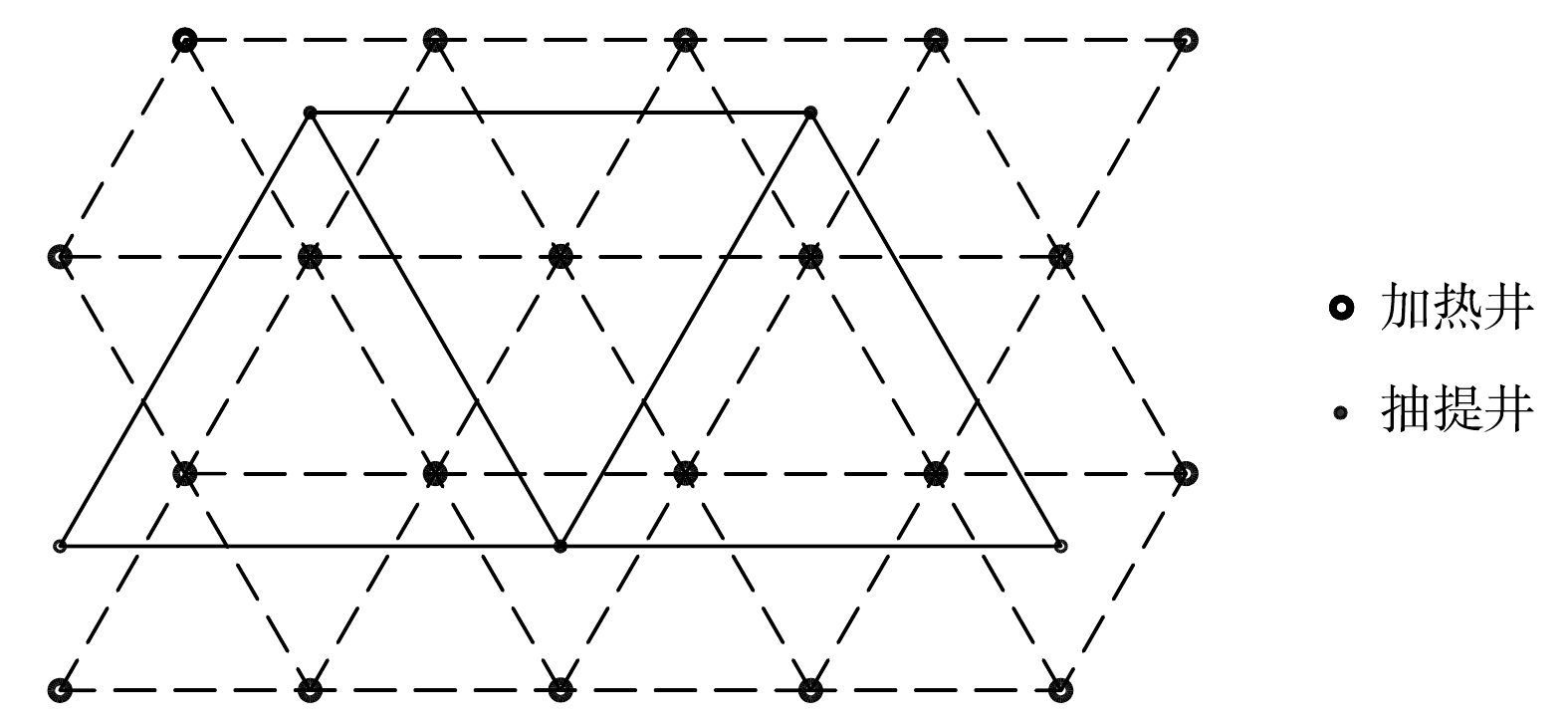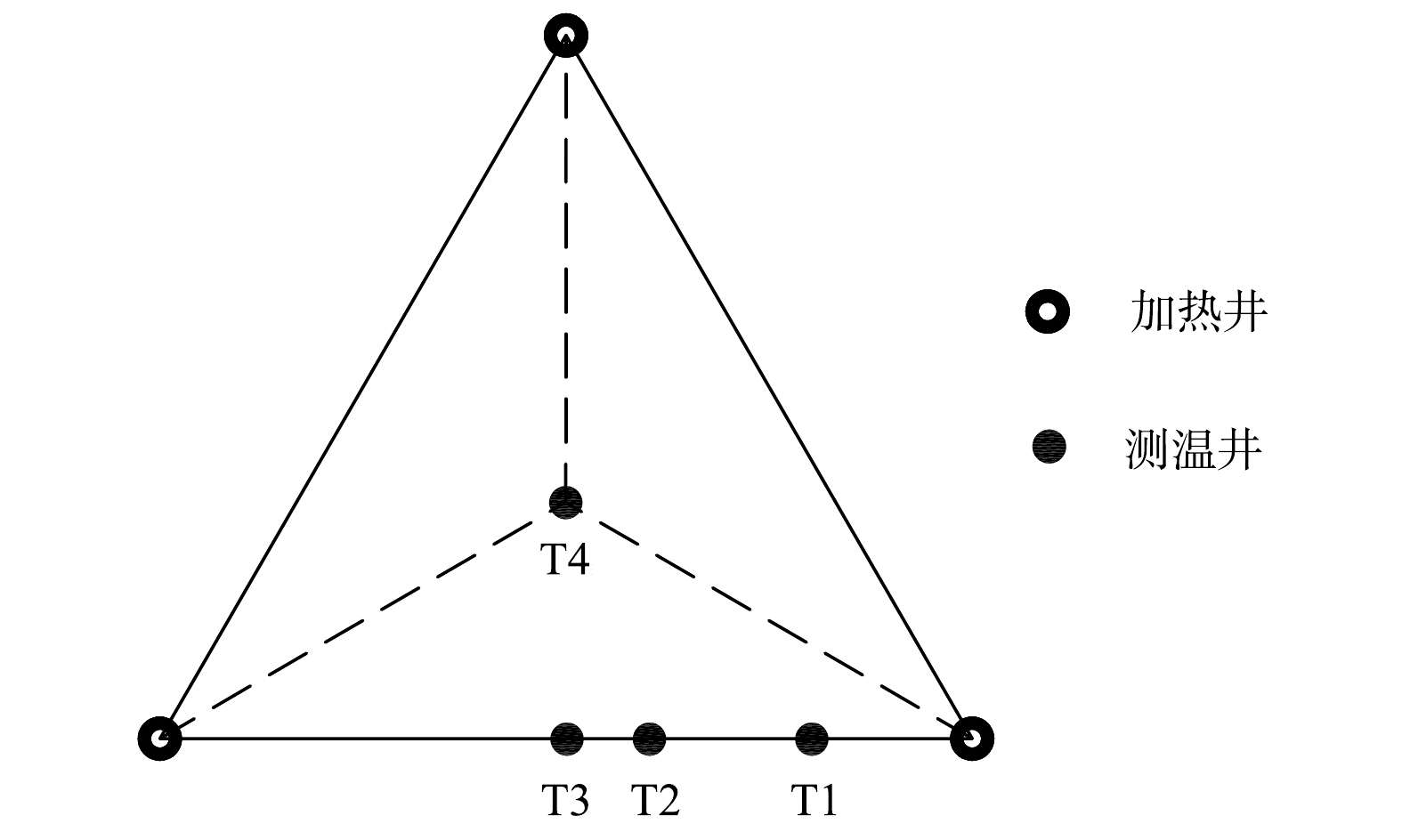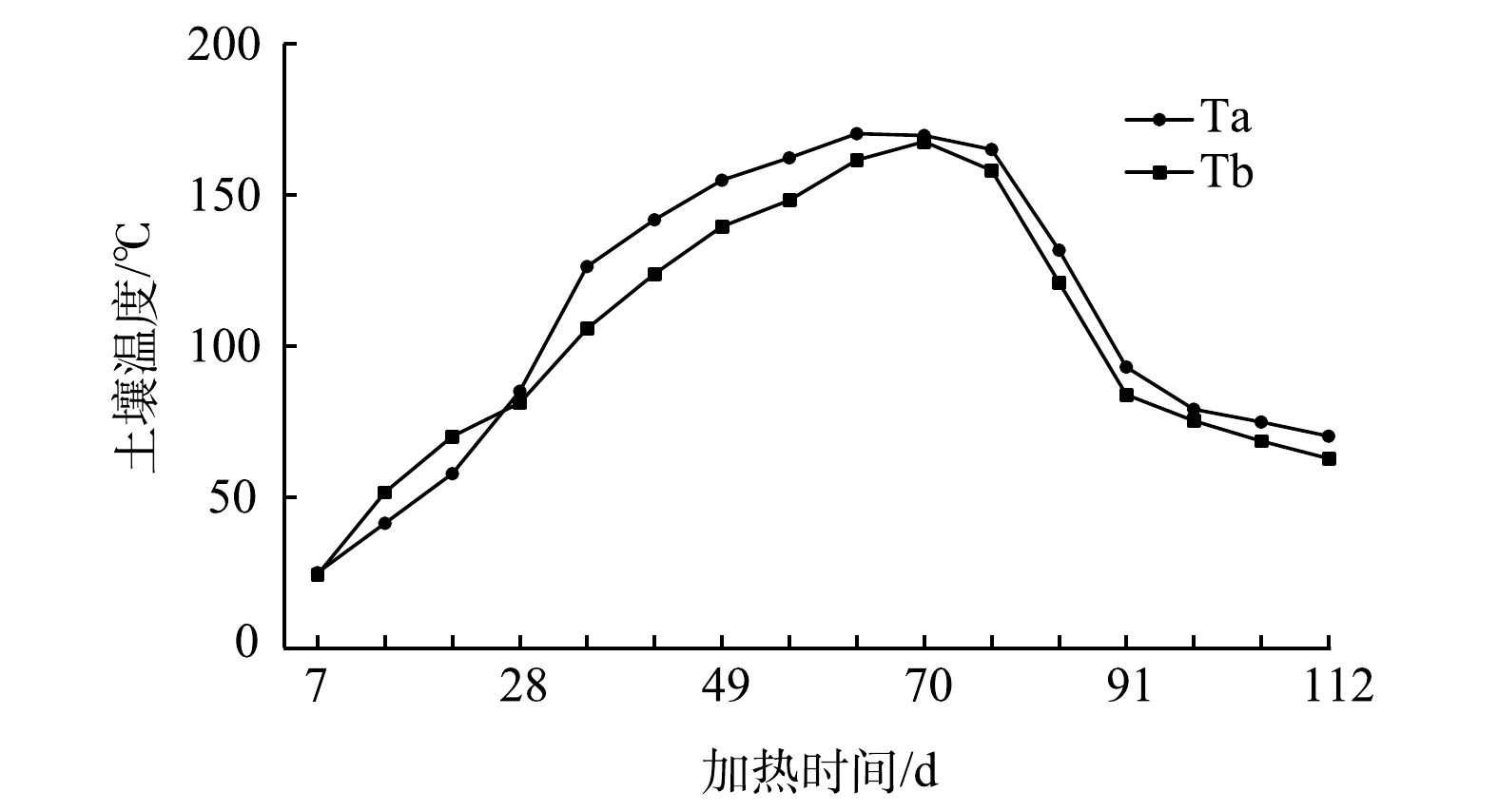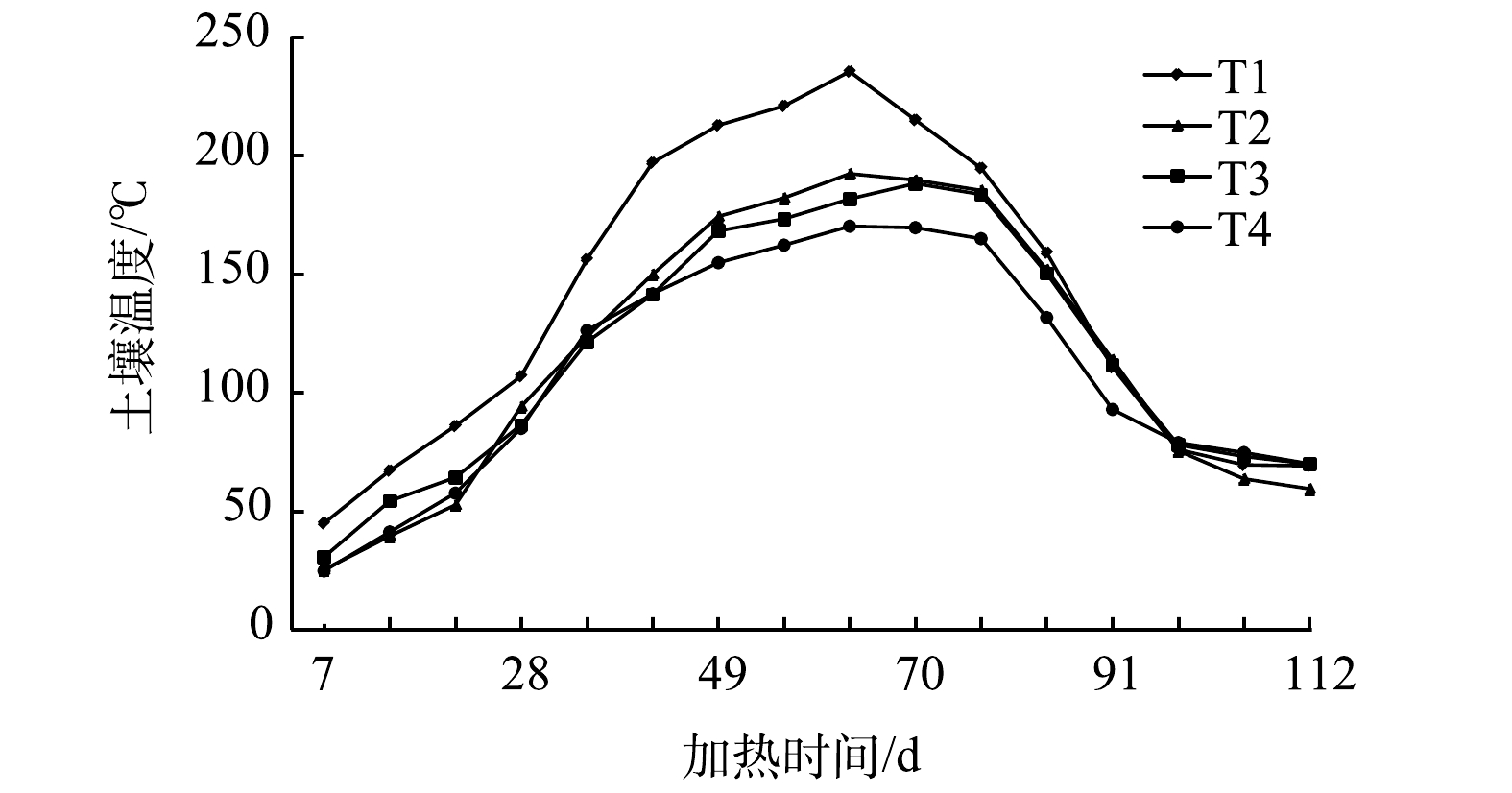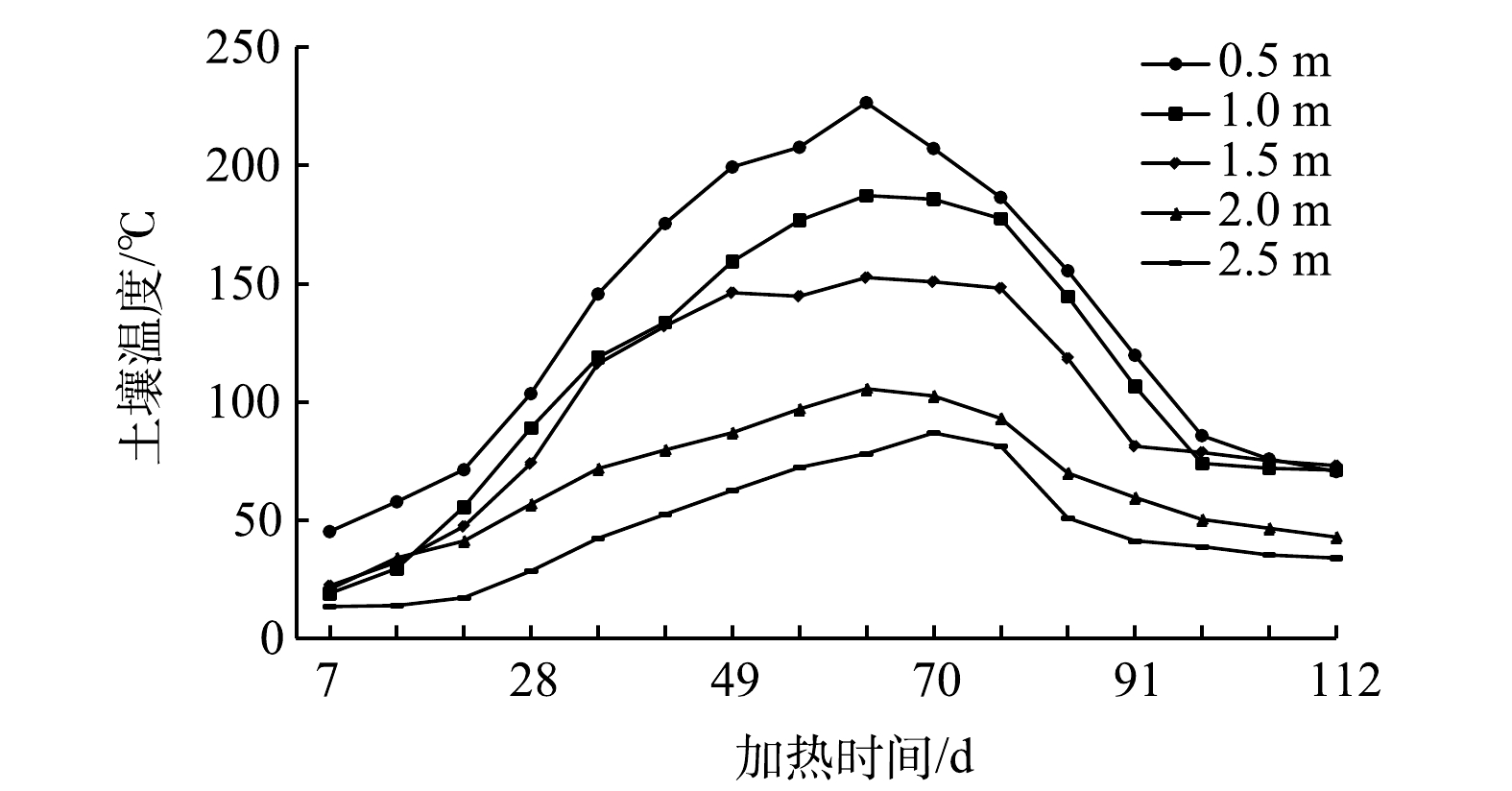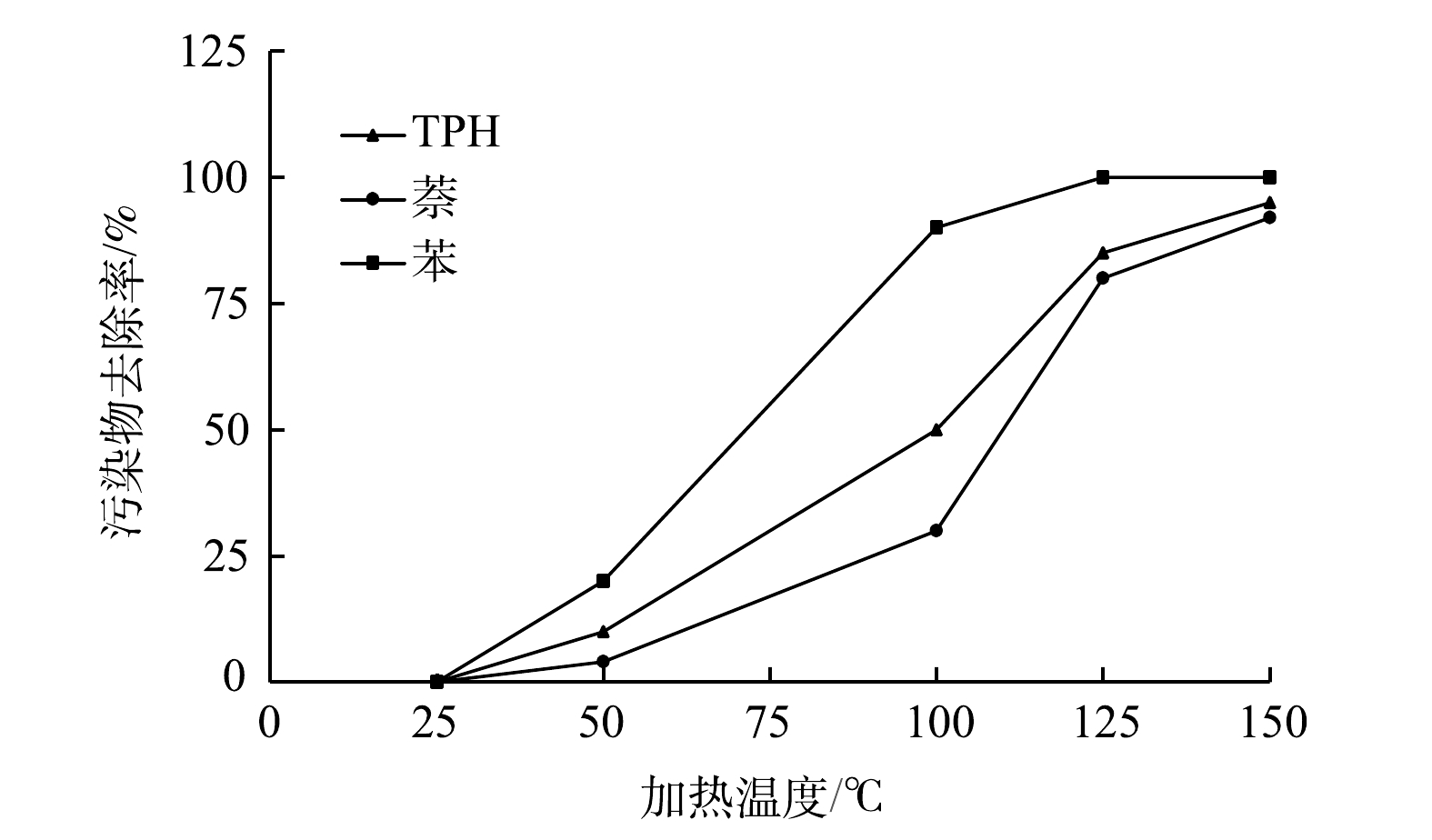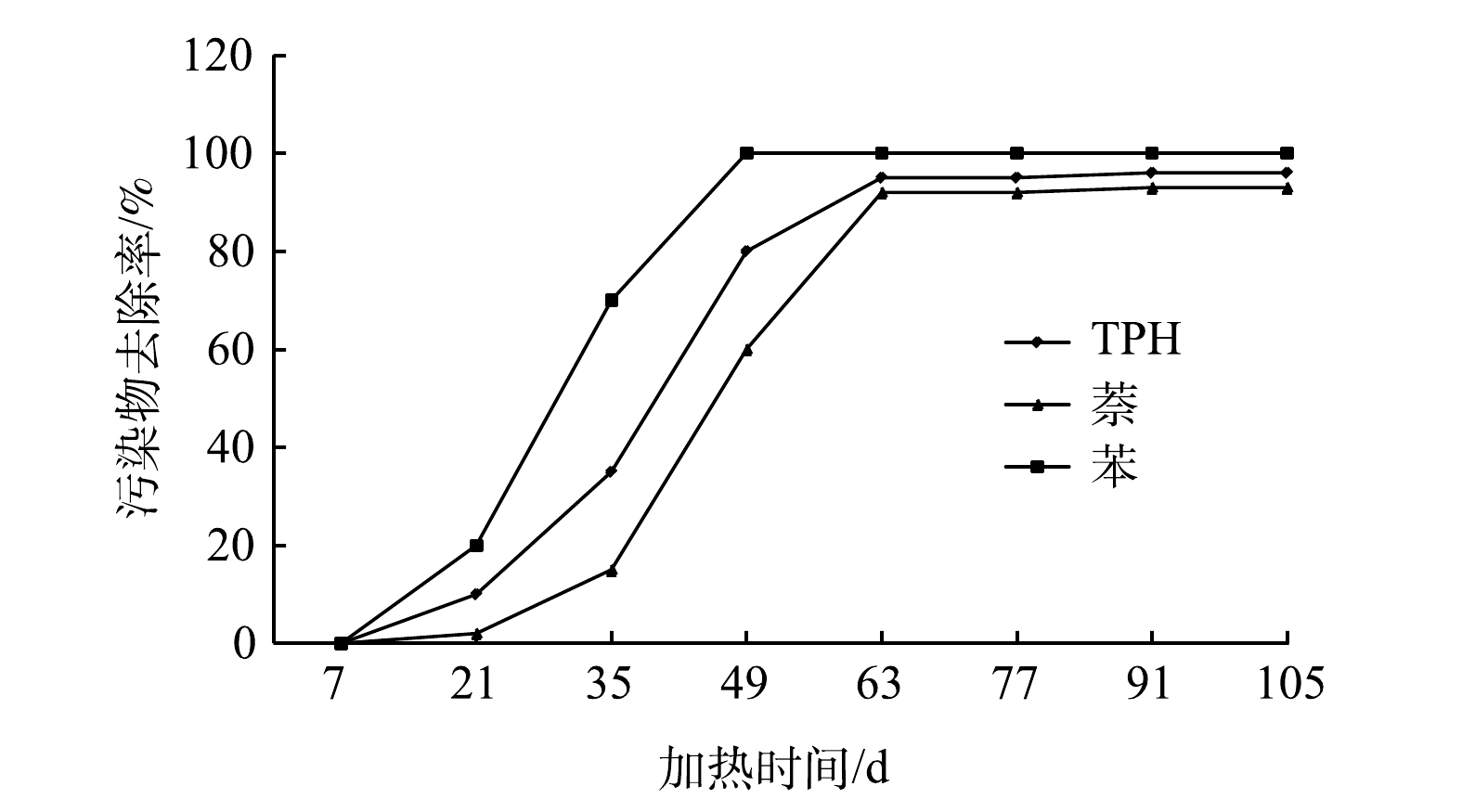-
近年来,随着城市化进程的加速,坚持人与自然和谐共生、坚持绿色发展已成为普遍共识,大量化工企业被迫搬迁或关停,从而遗留了大量污染地块[1-2],大多数遗留地块具有高污染、高风险的特点,对附近环境和人们的生活带来很大风险,因此污染地块修复已经刻不容缓[3-4]。
在有机污染土壤修复技术中,异位热脱附技术由于修复效果良好,在国内工程应用中比例较高,但对于一些建筑物附近或异味较重的污染地块,异位热脱附技术的应用受到很大限制[5-6]。由于原位热脱附技术具有适用范围广、环境干扰小和可操作性强等优点,该技术近几年受到人们广泛关注[7-10]。燃气热脱附技术(Gas thermal desorption,GTD)在原位热脱附技术中表现优异,GTD以天然气或液化石油气为能源,通过热传导方式加热污染地块,结合抽提装置实现降低地块污染物浓度的目的。GTD具有处理污染物种类多、土壤非均质性影响小、修复工艺简单等突出优点,目前GTD已经成为很多科研机构和环保公司重点关注技术[11-12]。
蒋村等[13]研究了原位热脱附技术对氯苯污染土壤修复影响因素,结果表明,当土壤加热目标温度设定为100 ℃时,90.0%土壤样品中氯苯去除率达99.0%以上,土壤粒径、土壤含水率对土壤氯苯热脱附去除效果也有较大影响。胡正等[14]研究了原位热脱附技术在有机污染地块中的修复效果,热脱附法对有机污染土壤有良好的去除效果,修复后土壤中萘、苯并(a)芘的检出质量分数≤0.8 mg·kg−1,总石油烃检出质量分数≤96.0 mg·kg−1,远小于污染物修复目标值,修复效果较好。张攀等[15]研究表明,在热脱附去除土壤中硝基苯的过程中,加热30 min后脱附效率为86.9%,在目标温度停留20 min后,脱附效率为91.0%,这说明加热至目标温度后的停留时间越长,热脱附效果越好。目前,针对距离加热井不同位置土壤温度峰值问题,冷凝废水中污染物浓度问题以及能耗问题的研究较少,本研究通过土壤温度变化、土壤污染物含量变化、冷凝废水污染物含量变化和能耗等进行分析,研究GTD在有机污染地块中土壤修复效果及影响因素,以为后续类似工程提供实践经验。
-
GTD应用于我国北方某退役煤气厂所遗留污染地块,地块面积为1 400.0 m2,污染深度为−4.0~−7.0 m,待修复地块地下水无污染。场地调查结果显示,主要污染物为TPH(C<16)、苯、萘等挥发性有机污染物,其中TPH、苯、萘最高浓度分别为4 720.0、19.4、529.0 mg·kg−1。3种污染物修复目标分别为826.0、6.4、63.7 mg·kg−1。地质勘察结果表明,污染地块修复区域可分为6个工程地质层,地层岩性分布如表1所示。同时,根据现场地层情况的不同,0~−2.0 m主要以杂填土为主,−2.0 m以下为原状土,分别对其理化性质进行了测试,具体信息见表2。
-
设备主要由加热系统、抽提系统、温度监测系统、冷却系统和尾气处理系统5部分组成。工艺流程图如图1所示。根据本地块污染物与水的共沸点,设定土壤加热的目标温度为150 ℃。首先,在土壤中安置加热管并通过天然气加热升温,高温气体由加热内管进入,然后通过加热外管后直接外排。加热管通过热传导方式加热周围污染土壤,并逐渐升高至目标温度。随着污染土壤温度的升高,目标污染物逐渐挥发,甚至裂解,含有污染物的蒸汽通过抽提井被抽提至地表,再经冷却系统将高温蒸汽进行降温,汽水分离后的气体通过净化处理后排放,液体暂存至储存罐,最后输送至废水处理系统进行无害化处置。在土壤加热过程中,利用压力监测和温度监测系统实时监控修复区域,并通过智能化、自动化控制系统对加热井温度进行实时调控。
-
通过地块水文地质勘测,地下水位在-30.0 m以下,无需做止水帷幕和降水处理。根据地块水文地质情况及计算结果,污染地块共布置加热井261口、抽提井63口、测温井43口和压力监测井14口,污染地块井位布置如图2所示。
加热井、抽提井布位设计。土壤加热温度与加热井排布方式有关,且加热井排布不适合会导致能源成本大幅度增加。本修复项目采用正三角排布方式对加热井进行布置,通过数值计算和中试实验,设定加热井间距为2.5 m,抽提井间距为5.0 m,抽提井均匀分布于加热井周围,具体排布如图3所示。
测温井布位设计。为了监测污染地块内土壤冷点温度变化,在修复区域内共布置测温井35口,测温井位于正三角排布的3口加热井中心点,如图4所示。测温井内共放置5个热电偶,热电偶深度位置分别为−0.5、−1.5、−3.0、−5.0、−7.0 m。
土壤导热系数较低,为研究单口加热井的周围土壤温度变化情况,在修复区域内选定1口加热井并在其附近设置一系列测温井,测温井与选定加热井的距离分别为0.50、1.00、1.25、1.44 m,具体位置如图5所示。
高温会对周边建筑物地基造成影响,因此需要监测加热井热量传导距离。本研究选择1口边界处加热井,研究其附近土壤温度变化。在加热井同一个方向设置一系列测温井,测温井与加热井的距离分别为0.5、1.0、1.5、2.0、2.5 m。测温井深度为−8.0 m,其中热电偶放置深度为−7.0 m。
-
污染地块修复后,在地块内布置13个采样点,采样点均在冷点位置,记为Q1~Q13。上层0~−4.0 m是未污染土壤,在采样点垂直方向上取2个土壤样品,间隔为2.0 m;下层−4.0~−7.0 m是污染土壤,垂直方向上取3个土壤样品,间隔为1.0 m,采样点具体位置如图6所示。
当土壤升至目标温度后,燃气热脱附装置仍维持加热7 d,然后进行土壤样品采集。样品采集后立即放入0~−4 ℃的冷藏箱内保存,并于48 h内送至实验室进行检测。实验室检测指标为苯、萘和TPH,检测设备为气质联用仪GC-MS(EXPEC 5231,杭州谱育科技发展有限公司)和气相色谱仪(GC 2000,杭州谱育科技发展有限公司),检测方法依据HJ 605-2011[16]。
污染地块地下水位较深,但浅层滞水会随土壤温度升高而逐渐蒸发,经抽提井至地表,然后经过冷凝系统形成冷凝废水。每14 d对冷凝废水进行检测1次,监测废水中污染物浓度变化,从而间接反映污染土壤修复效果。实验室检测指标为苯、萘和TPH,检测设备均为气相色谱仪(GC 2000,杭州谱育科技发展有限公司),检测方法分别依据HJ1067-2019[17]、GB/T5750.8-2006[18]和HJ894-2017[19]。
-
由于本地块内测温井较多,本研究选取2个具有代表性的测温井进行土壤温度变化分析,测温井记为Ta和Tb(具体位置见图4),土壤温度随时间变化如图7所示。由图可知,地块内冷点处土壤升至目标温度150 ℃约需要56 d。土壤升至目标温度后,热脱附装置持续加热7 d后停止加热,直至77 d时Ta和Tb处土壤温度才开始出现下降趋势。这是因为,热量在土壤中的传递需要一定过程,当停止加热时,冷点处土壤温度出现持续上升现象,该现象体现出温度变化的滞后效应。停止加热后,温度监测系统继续对土壤温度进行监测,112 d后土壤温度仍大于60 ℃。
为研究单口加热井附近土壤温度变化情况,在距离加热井0.50、1.00、1.25、1.44 m处分别设置测温井,对附近土壤温度进行监测,测温井记为T1、T2、T3和T4(见图5),温度变化情况如图8所示。测温井距离加热井越近,温度越高,当最远处测温井T4升至目标温度150 ℃时,其他测温井T1、T2、T3温度分别为221、182、173 ℃,均已超过目标温度。停止加热后初始阶段,一定时间内所有测温井温度仍会持续上升,且距离加热井越近的测温点达到温度峰值的时间越早,距离加热井越远的测温点达到温度峰值的时间越晚,温度呈现出明显滞后现象。T1、T2在第63 d分别升至温度峰值221、192 ℃,T3、T4在第70 d分别升至温度峰值188、170 ℃。
有文献表明[4,20],GTD加热井间距一般设置为1.5~4.0 m,通过计算,本项目中设定加热井间距为2.5 m。加热井间距越小,土壤升至目标温度所需时间越少,但所需布置的加热井数量增多,导致前期设备投资增加。同时,加热时间和加热井数量的不同会导致燃气消耗量不同。因此,需要综合考虑工期、成本、技术等各种影响因素,才能设计最佳加热井间距。
为研究加热区域边界外土壤温度变化,距离边界加热井的一侧设置不同距离(0.5、1.0、1.5、2.0、2.5 m)的测温井,土壤温度变化情况如图9所示。由图9可知,测温井距离加热井越近,温度峰值越高;距离加热井越远,温度峰值越低。2.5 m处土壤温度在第70 d时仍为86.8 ℃。为避免土壤热传导对周边建筑物地基造成影响,可根据建筑物地基材料的耐热性能,合理控制加热井与附近建筑物之间的距离。
-
污染地块土壤修复后共设置了13个土壤采样点。选择污染地块内3个具有代表性的取样点进行数据分析,如表3所示。土壤修复前,污染地块0~−4.0 m土壤未受到污染,−4.0~−7.0 m土壤均受到不同程度污染,TPH最高污染浓度为4 762.0 mg·kg−1,处于地下−5.0~−6.0 m;苯的最高污染浓度为18.4 mg·kg−1,处于地下−4.0~−5.0 m;萘的最高污染浓度为388.5 mg·kg−1,处于地下−4.0~−5.0 m。土壤修复后,TPH最高污染浓度为192.8 mg·kg−1,苯为未检出,萘的最高污染浓度为14.4 mg·kg−1,处于地下−6.0~−7.0 m。经过计算TPH去除率均在95%以上,萘去除率超过了92%,苯的去除率约为100%,且污染残留主要集中于抽提井尾端。由此可知,经GTD修复后土壤中大部分污染物已经转化为气相或液相被抽提出来,修复效果良好。
-
污染地块土壤加热过程中,水分会逐渐蒸发,土壤中污染物会以气体形式随水蒸汽一起通过抽提系统移出地面,经冷凝系统处理后部分气体转化为液体,不凝气通过尾气处理系统达标后排放。修复过程中,每14 d对冷凝的废水取样1次,每次取3个水样送至实验室检测,检测结果如表4所示。第7 d废水样品未检出污染物,这是因为刚开始加热时,土壤温度较低,污染物没有转化为气相被抽出。从第21 d起废水样品中检测出TPH和苯,至第35 d废水中才检测出萘,这是因为,随着加热时间的延长,土壤温度逐渐升高,高沸点污染物开始逐渐向气相转化,并随水蒸汽被抽提井抽出。冷凝废水中不同污染物浓度峰值出现的时间不同,苯浓度在第35 d升至峰值,而TPH和萘的浓度峰值分别出现在第35 d和第63 d,这与污染物沸点有关,沸点越低,废水中污染物浓度峰值出现越早,沸点越高,废水中污染物浓度峰值出现越晚。苯沸点80.1 ℃,萘沸点217.9 ℃,本地块中TPH主要为汽油馏分(C4~C12)和煤油馏分(C10~C16),其对应的沸点范围分别为50~200 ℃和130~250 ℃[21]。冷凝废水中污染物浓度间接反映污染土壤修复效果。
-
本项目自2021年9月20日开始运行,至2021年11月23日加热系统停止运行,从开始加热至停止加热共运行63 d,施工周期内共消耗天然气924 868.6 m3,消耗电量为453 600 kW·h,本项目共修复污染土壤11 200 m3,能耗分析结果如下:每处理1.0 m3污染土壤约消耗天然气82.6 m3,电量40.5 kW·h。
-
影响GTD修复效果的主要因素包括加热温度、停留时间、土壤含水率、土壤渗透性和加热井排布方式等[22-29]。利用温度和污染物含量变化等数据,对GTD修复效果影响因素进行分析与讨论。
1)加热温度。加热温度对污染物去除率影响较大,具体见图10。污染地块目标加热温度与污染物沸点有关,苯、萘和TPH的沸点分别为80.1、217.9 ℃和50~250 ℃。由拉乌尔定律可知,污染物和水混合物的沸点低于单独污染物的沸点,这使得目标加热温度无须超过污染物的沸点[23,30]。苯与水共沸点为69.3 ℃,萘与水的共沸点为98.8 ℃[31]。
当土壤平均温度超过50 ℃时,有机物苯和TPH中低沸点的汽油馏分开始逐渐向气相转化;当土壤平均温度超过100 ℃时,萘以及TPH中的汽油馏分和煤油馏分均开始逐渐向气相转化,随着加热时间增加,土壤温度升高,大量的TPH和萘开始向气相转化,这是由于TPH和萘从土壤中脱附所需的温度更高,开始向气相转化的时间点相对滞后。综上所述,GTD加热温度可直接影响污染物的去除效果。一般而言,目标温度越高,污染物去除效果越好,但污染物去除率与温度并非成线性关系,较高温度往往会伴随着其他副产物的生成和能耗的增加,因此最佳目标温度的确定须要综合考虑项目工期和成本等因素。
2)停留时间。土壤升温前期,加热温度起修复关键作用,当土壤温度升至目标温度后,停留时间则是影响修复效果的主要因素。在本项目中,土壤升至目标温度后继续加热7 d,即在目标温度停留时间为7 d,土壤中不同目标污染物的去除效果均较为理想。萘的最低去除率为92%,TPH的最低去除率为95%,苯的去除率约为100%(具体见图11)。修复后土壤中沸点较高的萘和TPH浓度虽然远低于修复目标值,但仍有少量残留,导致这一现象的原因可能是停留时间较短。综上所述,实际施工过程中,应综合考虑目标温度与停留时间等因素,在施工工期内以最低成本完成污染土壤修复。
3)土壤含水率。在GTD修复土壤过程中,土壤含水率会对升温时间产生影响,含水率越低,土壤升至目标温度所需时间越短。因此加热前降低土壤含水量,可大幅度缩短升温时间。本项目地下水位较深,无须进行降水处置,但须要在场地表层进行混凝土防护,阻止降水对施工区域土壤含水率的影响。此外,土壤含水率还影响污染物去除效果,降低土壤含水率会导致土壤通透性增大,有利于有机污染物的挥发。这是因为,土壤含水率较高液态水会占据大量的空隙,阻碍空气的流通路径。土壤含水率会对能耗产生影响,土壤含水率越高,则土壤升至目标温度所须能量就越多。水的比热容为4.2×103 J·kg−1·℃−1,土壤比热容为0.8×103 J·kg−1·℃−1,水的较热容比土壤大,土壤含水率越高,水分在加热过程中吸收的能量越多,能耗越大。当目标温度高于100 ℃,土壤中水分须经过由液态水转化为气态水的过程,水的汽化热为2.3×106 J·kg−1,远高于液态水和土壤比热容,须消耗更多热能。本地块目标温度为150 ℃,因此,降低含水率可以大幅度降低整体能耗,提高污染土壤修复效率。
4)土壤渗透性。渗透性指由浓度差引起的水分净移动能力,是影响有机污染物在土壤中扩散速度的重要参数。高国龙等[32]研究表明,渗透性较好土壤中的有机物更容易被抽提,去除效率更高[33-34]。周启星等[35]研究表明,当土壤渗透性大于10−4 cm·s−1时,土壤中空气流动较通畅,当土壤渗透性小于10−6 cm·s−1时,土壤中空气流动受到较大影响。经检测,本项目污染地块中地下0~−2.0 m主要为杂填土,−2.0~−8.0 m主要为粉砂土,渗透系数在4.0×10−5 cm·s−1以上,在加热过程中,土壤受热后会出现不同程度裂缝,增大土壤渗透系数,因此,在GTD修复过程中,有机物在土壤孔隙中的扩散速度不会受到较大影响,热脱附效率较高。
综上所述,采用GTD修复有机物污染土壤,须要综合考虑加热温度、停留时间、土壤含水率、土壤渗透性等影响因素。可以根据污染物性质、工期等因素选定合适的目标温度和停留时间。此外,为了避免二次污染,需要对GTD修复过程中产生的废气和废水进行有效收集和无害化处理。
-
1)当燃气热脱附加热井间距为2.5 m,加热时间为56 d,污染土壤升至目标温度150 ℃,停止加热后进行土壤检测,污染物萘、TPH和苯的去除率分别为92%、95%和100%,污染物含量均在修复目标值之下。
2)本项目以天然气和电能为能源,每处理1.0 m3污染土壤约消耗天然气82.6 m3,电量40.5 kW·h。
3)冷凝废水中不同污染物浓度峰值出现的时间不同,苯浓度在第35 d升至峰值,而TPH和萘的浓度峰值分别出现在第49 d和第63 d。沸点越低,污染物去除率峰值出现越早;沸点越高,污染物去除率峰值出现越晚。
燃气热脱附技术土壤修复效果及影响因素
Soil remediation effect and influencing factors of gas thermal desorption technology
-
摘要: 以某退役煤气厂土壤中苯、萘和TPH为目标污染物,基于燃气热脱附技术开展了工程化的修复。当加热井间距为2.5 m,加热56 d,土壤可升至目标温度150 ℃,土壤中苯、萘和TPH的去除率分别为100%、92%和95%,均达到目标修复值。研究发现,沸点越低,污染物去除率峰值出现越早;沸点越高,污染物去除率峰值出现越晚。停止加热后,测温点距离加热井越近,温度升至峰值的时间越早;测温点距离加热井越远,温度升至峰值的时间越晚,温度呈现出明显的滞后现象。通过能耗分析,每处理1.0 m3污染土壤约消耗天然气82.6 m3,电量40.5 kW·h。本研究结果可为利用燃气热脱附技术进行土壤修复工程提供参考。Abstract: Taking benzene, naphthalene and TPH in the soil of a de-commissioned gas plant as the target pollutants, the engineering remediation was carried out based on gas thermal desorption technology in this study. The temperature of the studied soil reached 150 °C after 56 days of heating with the heating wells placed 2.5 m from each other. Accordingly, the removal percentages of benzene, naphthalene and TPH reached 100%, 92% and 95%, respectively, which all met the remediation targets. During the heating process, the time required to reach peak removal percentages for different pollutants was inversely correlated to the boiling points of the pollutants. In terms of the temporal-spatial variation of the temperatures, after the heating was stopped, it has been observed that the time required to reach peak temperature was inversely correlated to the distance from the heating well, and there was an apparent hysteresis effect on temperature profile. A cost-effectiveness study revealed that 82.6 m3 of natural gas and 40.5 kW·h of electricity was needed to treat each cubic meter of polluted soil. This study can provide reference for soil remediation by gas thermal desorption technology.
-
Key words:
- gas thermal desorption /
- soil remediation /
- organics contaminated site /
- gas heating
-

-
表 1 地块地层岩性分布
Table 1. Stratigraphic lithologic distribution of site
标准层号 分层厚度/m 岩土名称及特征 1 0~1.9 杂填土:呈杂色,主要由建筑垃圾构成,含碎砖、水泥块、砂土、粉土等。无刺激性气味。 2 0.5~1.0 粉土:呈褐黄色,含云母、氧化物及较多石英矿物。常混较多砂质成分,局部夹薄层细沙或粗砾砂。无刺激性气味。 3 1.0~1.9 粗砂砾:呈褐黄,矿物组成主要为石英、云母、长石等,常混有大量粗砂及少量圆砾,局部混有大量细砂。 4 0.5~0.9 粉土:呈褐黄,含云母、氧化物及较多石英矿物等,局部夹薄层粗砂砾,有轻微刺激性气味。 5 4.0~6.6 粗砂砾:呈褐色,矿物组成主要为石英、云母、长石等,级配不良。常混有大量粗砂及少量圆砾,局部混有大量细砂,常夹薄层粉土。有轻微刺激性气味。 6 1.0~2.0 粉土:呈褐黄,含云母、氧化铁等,常混有较多粉质粘土。无刺激性气味。 表 2 地块各土层理化性质
Table 2. Physical and chemical properties of every soil in site
特征参数土壤 单位 第一层
(0~−2.0 m)第二层
(−2.0~−8.0 m)填土 粉砂土 含水率 — 22.4% 23.6% 湿密度 g·cm−3 1.9 1.9 干密度 g·cm−3 1.6 1.6 饱和度 — 90.9% 93.2% 孔隙比 — 0.6 0.6 渗透系数 cm·s−1 4.3×10−5 5.3×10−5 pH — 8.9 9.3 有机质含量 g·kg−1 10.1 5.9 导热系数 W·(m·K)−1 1.7 1.8 表 3 土壤中目标污染物浓度变化
Table 3. Concentration variation of target pollutants in soil
目标污染物浓度/(mg·kg−1) 污染物名称 取样编号 0~−2.0 m −2.0~−4.0 m −4.0~−5.0 m −5.0~−6.0 m −6.0~−7.0 m 修复前 修复后 修复前 修复后 修复前 修复后 修复前 修复后 修复前 修复后 TPH Q1 78.6 未检出 24.9 未检出 4 021 19.8 4 286 23.8 3 469 15.6 Q5 50.8 未检出 93.4 未检出 4 439 187.3 4 762 96.3 3 943 192.8 Q9 60.7 未检出 140.7 未检出 2 143 未检出 2 537 12.2 1 814 26.6 苯 Q1 4.5 未检出 未检出 未检出 18.4 未检出 16.2 未检出 12.9 未检出 Q5 未检出 未检出 未检出 未检出 11.3 未检出 14.4 未检出 10.1 未检出 Q9 未检出 未检出 未检出 未检出 9.5 未检出 15.8 未检出 5.8 未检出 萘 Q1 24.6 未检出 19.8 未检出 248.8 未检出 277.3 未检出 183.5 14.4 Q5 未检出 未检出 未检出 未检出 58.9 未检出 87.4 未检出 86.5 未检出 Q9 34.5 未检出 未检出 未检出 388.5 未检出 298.4 未检出 104.3 未检出 表 4 冷凝废水中目标污染物含量变化
Table 4. Concentration variation of target pollutants in condensate wastewater
污染物名称 单位 编号 目标污染物浓度 第7 d 第21 d 第35 d 第49 d 第63 d 第77 d 第91 d 第105 d TPH mg·L−1 1 未检出 6.08 84.36 134.65 54.26 14.48 4.96 5.83 2 未检出 7.48 99.42 159.49 69.38 8.89 15.58 8.74 3 未检出 5.88 87.17 134.08 60.35 12.72 9.62 0.79 苯 μg·L−1 1 未检出 28.87 66.78 15.78 5.43 未检出 未检出 未检出 2 未检出 25.73 69.31 14.99 4.82 未检出 未检出 未检出 3 未检出 31.49 63.49 14.65 5.04 未检出 未检出 未检出 萘 μg·L−1 1 未检出 未检出 14.59 88.83 134.59 34.53 0.83 0.04 2 未检出 未检出 15.03 79.45 129.86 29.78 0.76 0.04 3 未检出 未检出 14.88 83.92 132.24 29.48 0.77 0.03 -
[1] 吴嘉茵, 方战强, 薛成杰, 等. 我国有机物污染场地土壤修复技术的专利计量分析[J]. 环境工程学报, 2019, 13(8): 2015-2024. doi: 10.12030/j.cjee.201812195 [2] 王艳伟, 李书鹏, 康绍果, 等. 中国工业污染场地修复发展状况分析[J]. 环境工程, 2017, 35(10): 175-178. [3] CHEN M. Analytical integration procedures for the derivation of risk-based generic assessment criteria for soil[J]. Human and Ecological Risk Assessment, 2010, 16: 1295-1317. doi: 10.1080/10807039.2010.526502 [4] YANG H, HUANG X, THOMPSON J R, et al. China’s soil pollution: Urban brownfields[J]. Science, 2014, 344(6185): 691-692. [5] 陶欢, 廖晓勇, 阎秀兰, 等. 应用多属性决策分析法筛选污染场地土壤修复技术[J]. 环境工程学报, 2017, 11(8): 4850-4860. doi: 10.12030/j.cjee.201707165 [6] 白利平, 罗云, 刘俐, 等. 污染场地修复技术筛选方法及应用[J]. 环境科学, 2015, 36(11): 4218-4224. [7] MYERS K F, KARN R A, ENG D Y, et al. In situ thermal desorption of VOCs in vadose zone soils[J]. Field Analytical Chemistry & Technology, 2015, 2(3): 163-171. [8] KUNKEL A M, SEIBERT J J, ELLIOTT L J, et al. Remediation of elemental mercury using in situ thermal desorption (ISTD)[J]. Environmental Science & Technology, 2006, 40(7): 2384-2389. [9] BONNARD M, DEVIN S, LEYVAL C, et al. The influence of thermal desorption on genotoxicity of multi-polluted soil[J]. Ecotoxicology and Environmental Safety, 2010, 73(5): 955-960. doi: 10.1016/j.ecoenv.2010.02.023 [10] BING Y, XUE N, DING Q, et al. Polychlorinated biphenyls removal from contaminated soils using a transportable indirect thermal dryer unit: implications for emissions[J]. Chemosphere, 2014, 114(22): 84-92. [11] 刘志阳. 一种原位燃气热脱附土壤修复装置: ZL 201820382578.1. X[P]. 2018-12-11. [12] 牛晓阳, 石德升, 赵颖, 等. 污染土壤燃气原位热脱附修复系统: ZL 201811448227.7. X[P]. 2018-11-30. [13] 蒋村, 孟宪荣, 施维林, 等. 氯苯污染土壤低温原位热脱附修复[J]. 环境工程学报, 2019, 13(7): 1720-1726. doi: 10.12030/j.cjee.201810082 [14] 胡正, 沈青. 原位热脱附技术在有机污染地块中的修复效果研究[J]. 环境科技, 2020, 33(6): 30-34 doi: 10.3969/j.issn.1674-4829.2020.06.006 [15] 张攀, 高彦征, 孔火良. 污染土壤中硝基苯热脱附研究[J]. 土壤, 2012, 44(5): 801-806. doi: 10.3969/j.issn.0253-9829.2012.05.015 [16] 中华人民共和国环境保护部. 土壤和沉积物挥发性有机物的测定吹扫捕集/气相色谱-质谱法: HJ 605-2011[S]. 北京: 中国环境科学出版社, 2011. [17] 中华人民共和国生态环境部. 水质苯系物的测定顶空/气相色谱法: HJ 1067-2019[S]. 北京: 中国环境科学出版社, 2019. [18] 中华人民共和国卫生部, 中国国家标准化管理委员会. 生活饮用水标准检验方法有机物指标: GB/T 5750.8-2006[S]. 北京: 中国标准出版社, 2006. [19] 中华人民共和国环境保护部. 水质可萃取性石油烃(C10-C40)的测定气相色谱法法: HJ 894-2017[S]. 北京: 中国环境科学出版社, 2017. [20] 张学良, 廖朋辉, 李群, 等. 复杂有机物污染地块原位热脱附修复技术的研究[J]. 土壤通报, 2018, 49(4): 993-1000. [21] 昊平, 于桂红, 于松峰, 等. 石油馏分组成[J]. 科技信息, 2011, 25: 35-36. doi: 10.3969/j.issn.1001-9960.2011.24.028 [22] ASTON D P, KUEPER B H. Thermal conductive heating in fractured bedrock: Screening calculations to assess the effect of groundwater influx[J]. Advances in Water Resources, 2009, 32(2): 231-238. doi: 10.1016/j.advwatres.2008.10.019 [23] MUNHOLLAND J L, MUMFORD K G, KUEPER B H. Factors affecting gas migration and contaminant redistribution in heterogeneous porous media subject to electrical resistance heating[J]. Journal of Contaminant Hydrology, 2016, 184: 14-24. doi: 10.1016/j.jconhyd.2015.10.011 [24] KROUZEK J, DURDAK V, HENDRYCH J, et al. Pilot scale applications of microwave heating for soil remediation[J]. Chemical Engineering and Processing Process Intensification, 2018, 130: 53-60. doi: 10.1016/j.cep.2018.05.010 [25] ZHAO C, DONG Y, FENG Y, et al. Thermal desorption for remediation of contaminated soil: A review[J]. Chemosphere, 2019, 221: 841-855. doi: 10.1016/j.chemosphere.2019.01.079 [26] HERON G, PARKER K, GALLIGAN J, et al. Thermal treatment of eight CVOC source zones to near nondetect concentrations[J]. Ground Water Monitoring and Remediation, 2009, 29(3): 56-65. doi: 10.1111/j.1745-6592.2009.01247.x [27] 孙磊, 蒋新, 周健民, 等. 五氯酚污染土壤的热修复初探[J]. 土壤学报, 2004, 41(3): 462-465. doi: 10.3321/j.issn:0564-3929.2004.03.021 [28] 赵涛, 马刚平, 周宇, 等. 多环芳烃类污染土壤热脱附修复技术应用研究[J]. 环境工程, 2017, 35(11): 178-181. [29] 王瑛, 李扬, 黄启飞, 等. 温度和停留时间对DDT污染土壤热脱附效果的影响[J]. 环境工程, 2012, 30(1): 116-120. [30] ZHAO C, MUMFORD K G, KUPPER B H. Laboratory study of non-aqueous phase liquid and water co-boiling during thermal treatment[J]. Journal of Contaminant Hydrology, 2014, 164: 49-58. doi: 10.1016/j.jconhyd.2014.05.008 [31] 程能林. 溶剂手册(第四版)[M]. 北京: 化学工业出版社, 2007. [32] 高国龙, 蒋建国, 李梦露. 有机物污染土壤热脱附技术研究与应用[J]. 环境工程, 2012, 30(1): 128-131. [33] FISCHER U, SCHULIN R, KELLER M. Experimental and numerical investigation of soil vapor extraction[J]. Water Resources Research, 1996, 32(12): 3413-3427. doi: 10.1029/95WR02668 [34] ALBERGARIA J T, ALVIM-FERRAZ M C M, DELERUE-MATOS C. Soil vapor extraction in sandy soils: Influence of airflow rate[J]. Chemosphere, 2008, 73(9): 1557-1561. doi: 10.1016/j.chemosphere.2008.07.080 [35] 周启星, 宋玉芳. 污染土壤修复原理和方法[M]. 北京: 科学出版社, 2004. -




 下载:
下载:

